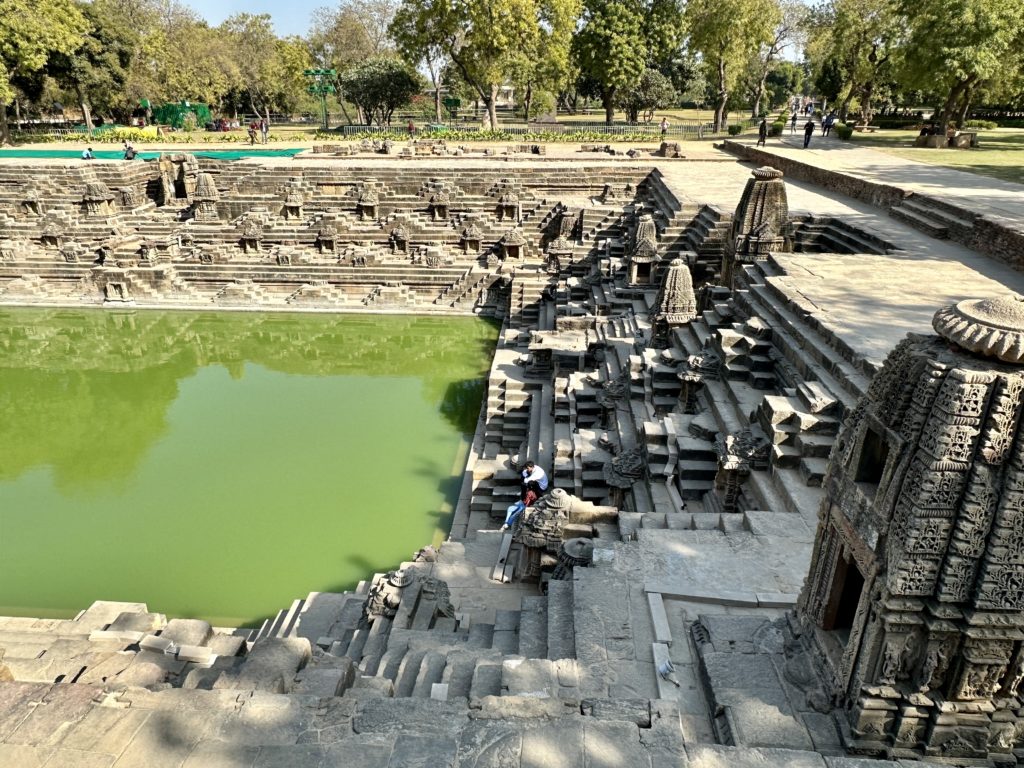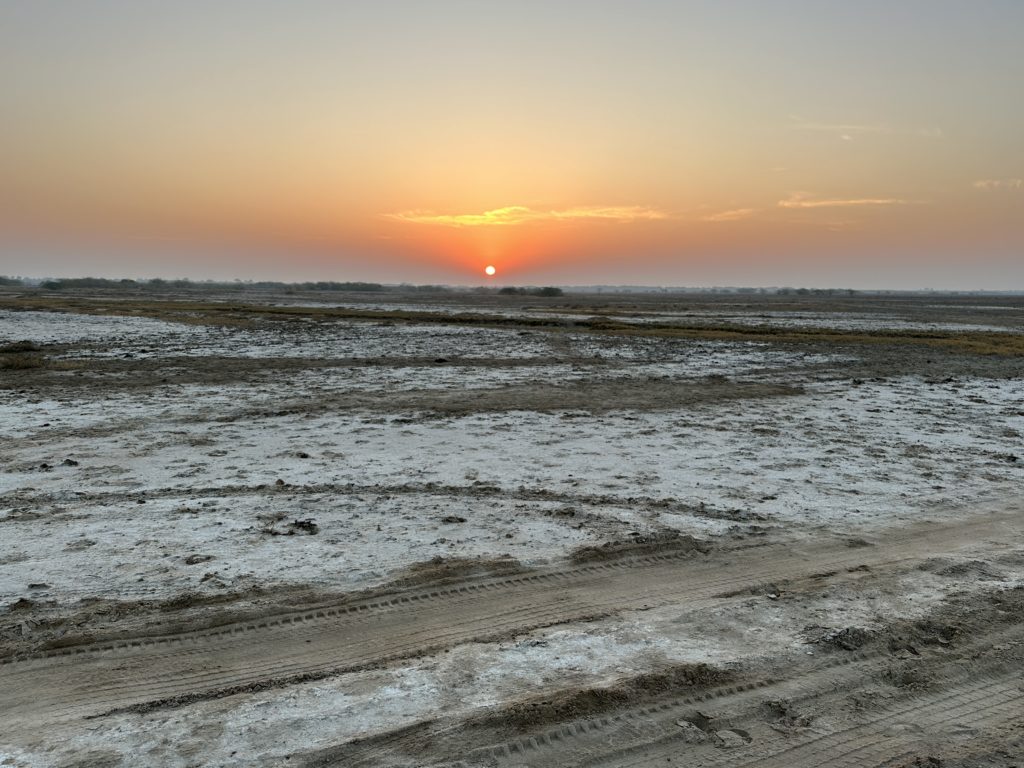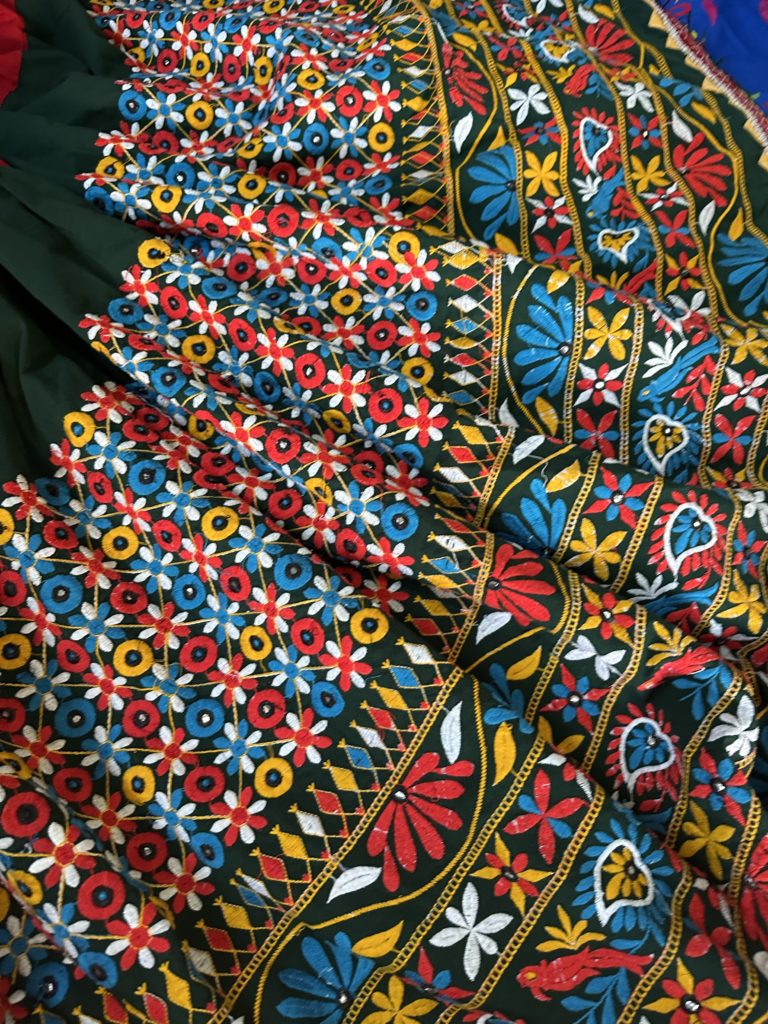Kite festival and jetlag in Ahmedabad
Jetlag sucks. I had a lovely flight from London to Dubai – three seats to myself, super quiet, a nice lunch and some excellent movies. From Dubai boarding the direct flight to Ahmedabad was an abrupt reentry to India. It was chaos – at least 20 babies, and more toddlers – almost all of whom were being entertained with cartoons being played on iPhones with the volume up loud. I know kids can’t wear headphones, but I am sure our parents managed to entertain us without deafening everyone around them (I could hear it all even through the noise cancelling headphones). No-one sat in their seat, deals where done to trade seats, and my initial very large neighbour who took up a considerable portion of my seat swapped with a couple with a baby, and the cute baby head butted me in the arm all the way to Ahmedebad. Fortunately, I was swift off the plane, and managed to get through immigration and out of the airport in 15 minutes, so fast I had to call the booked driver and I woke him up.
I am back in India for a tour around Gujarat, one of the least visited states. I largely copied my tour from Wild Frontiers and just directly booked my hotels and a car and driver (about £45 per day including fuel). I was arriving on the last day of the very famous kite festival and was excited to check out Ahmedabad – one of the first cities to be named a world heritage site.
I managed a few hours of sleep in the hotel before the cleaning staff woke me up and I managed to rouse myself for a walk around town. I was heading to the kite festival and it was lovely to see half of the town out in the streets and empty spaces flying small kites. I made a few navigation errors and ended up in an open toilet in a riverside slum. Hmmmm. It was one of those moments I knew I was definitely in the wrong place and about 100 people were watching me and one was yelling ‘foreigner’ at me. Either I walk forward confidently looking like I know where I am going, or I turn around – always a bad idea as it looks like I am lost. I brazened it out and found an exit to a main street and managed to cross the river to the kite festival. I don’t have any good photos as it is hard to photograph huge crowds staring at big kites in the sky.
I wandered back over the old town, stopping in the hotel for a pee, and I promptly passed out for three hours. Roused and a bit drowsy, I headed out to meander around the old town. It was hectically busy in the market near the fort, but the area around the mosque was lovely with families and kids crowding rooftops flying their kites. It was a lovely wander, with lots of warm ‘welcome to India’s. It headed back at sunset for an early dinner and passed out.



















I rewalked the same terrain in the morning. Very quiet with the aftermath of kite war carnage. A few people rousing themselves for the day, and a surprising number of cows and sheep – one guy in the old town was milking his cow in the Main Street. The highlight of the old town was the Siddi Sayed mosque – which has a beautiful carved window of the tree of life. The fort and Jama Masjid were also nice. But it was quite delightful just to wander around enjoying the buildings – an odd mix of run down havelis and Art Deco masterpieces (Le Corbusier designed quite a few of the buildings in Ahmedabad)
There were a lot of homeless people on the streets – living in the most dignified way possible, watching them wake up, carefully pack up their limited possessions, brush their teeth and prepare for their day. Back to the hotel for a quick coffee and then I met my driver Mr Bhai who was taking me up to Poshina.









Palatial Poshina
Poshina doesn’t feature in the guidebooks, but I had read about the crown prince who ran a small hotel in Poshina called the Darbargadh Palace, and it was on one of the Wild frontiers itineraries so I thought worth checking out. Harendrapal Sinh is the charming, cheeky and effervescent descendent of the original Poshina royal family. The palace is delightful, and it was like staying with old friends who were slightly eccentric. I was welcomed by Dan who played a drum as I got out of the car, and then had a delicious lunch in the courtyard. My room was larger than flats I have lived in.
Dan took me out for a walk around the village. Our conversation was limited to the few English and hindu words we had in common, but he did take me to buy a terracotta horse to make as an offering later in the day. They are quite lovely, and typically offered for good harvests or more children. The bustling village of Poshina was very nice, but there is a bit of an alcohol problem. Gujarat is a dry state but the locals get around that by brewing gut rot spirit and selling it by the river in 20pence plastic bags. Dan and I ran into this problem live in the village, with some very drunk guy shouting at one of us (we couldn’t figure out which) and then Dan whacked him across the head with his walking stick and suggested we promptly ‘challo’ (to) to the hotel.
I hadn’t had quite enough steps for the day, so I left Dan at the hotel after establishing with the boss that the drunk guy was just drunk, and headed in the other direction for a stroll along the river.













Terracotta fertility horses
Harendrapal took me and four other guests (four 21 year olds voyaging for two weeks in palaces as a birthday gift from one of their parents – yes eyebrow raise) to the local village to see the terracotta shrine for sunset. The light was magnificent, and I made my horse offering for happiness (definitely not fertility – though HP suggested it was not too late for a 49 year old to have kids). And then I played with the village kids who wanted photos taken. Back to the palace for an excellent dinner and then an early night in my palatial bed.









Poshina village life
I got up at dawn to go for a short jog (I am trying to get my achilles moving again). It is always lovely to watch a village wake up. I had three cups of coffee and then HP and I headed out to visit the local villages. We saw another terracotta horse shrine and I chatted to the local ladies and girls as they carried water back to the village. HP is very well known in all the villages as his family and he contribute books, blankets, food etc when they can. And he is on a personal lifelong mission to improve the lives of the tribes people (including figuring out how to get tourists to help them). The villages have decent food (as they all have fields and cattle), free schooling, but very poor healthcare and sanitation. The kids were incredibly well behaved throughout, though I figured out why as we were leaving as HP got out a huge bag of biscuits and the kids lined up and calmly took two each before scampering off.





















Grumpy Garacia 🙂
We then went to the border with Rajasthan to see some of the Garacia people who dress in distinctive pleated skirts. They were a little less friendly but it was fun watching them load up on the jeeps to get from place to place. It is hard to figure out how the drivers navigate with stuff piled up on the bonnet and just a small space left for them to look through. My favourite driver was steering with one butt cheek on the seat and one hanging out the open door.








Hanging with the Rabaris – and my sister from another mister
HP then said we were going to have lunch with some Rabari shepherds. That sounded fun. I expected lunch in a field surrounded by sheep but instead we arrived in a big compound (where sheep would be at night) and a met very cool family. I met literally everyone in four generations from the family. Leela – my sister from another mister – was a very loud and chatty Rabari who was ordering everyone around, including me. She made me an incredible lunch of millet chapati with buffalo butter, ghee, yogurt curry and potatoes. We then lay on the char poi and had tea. It was very sad to leave them, I got huge hugs from Leela and her Mother in law who kept patting my face.


















Where are the shepherds?
Given we hadn’t actually seen shepherds HP decided we needed to find some on the way home, so we drove around and then went on a bit of a bush whack to find three very photogenic shepherds who were super happy to meet their first gora/foreigner. They were lovely and kept posing for shots and laughing at them, so we stayed for a while until the sun started setting and we headed home.
I had an early dinner while the rest of the hotel guests were listening to drums and then then did four hours of board meetings on zoom. The advantage of the Indian time zone is I can be a tourist all day and semi professional at night.






















I had an early dinner while the rest of the hotel guests were listening to drums and then then did four hours of board meetings on zoom. The advantage of the Indian time zone is I can be a tourist all day and semi professional at night.
Stepwells and Sunshine
After an early morning coffee and a very fond farewell to the team at Poshina, I headed out with Mr Singh for the drive to Dasada. Our first stop was the Kumbaria jain temple. The Jains are one of the big minority religions in India. Jains seek the path to spiritual purity through disciplined non violence to all living things. Strict Jains wear cloth across their mouths so they don’t accidentally eat bugs, and most Jains are veg, and won’t even eat root vegetables as harvesting them kills the plant. There are similarities with Buddhism and Hinduism and their temples have lots in common. It was a lovely quiet temple, with only a couple of other visitors.




We then headed to Patan’s Ravi ki Vav stepwell. This monument is on the 100 rupee note, and features steps leading down through multiple levels and more than 800 sculptures – many of women dancing. I was most amused watching some of the local ladies try to navigate the stairs in high heels. Several gave up and carried their shoes.










My driver encouraged me to also visit the Patola centre – where Ikat weaving was invented. I am normally not a fan of weaving centres, but this was quite fascinating (and the google reviews I read before agreeing to go were also excellent). The individual strands of silk are each dyed 4-5 times with different colours so that the pattern forms when the thread is woven together – it requires extraordinary planning. Saris take six months to make and they have a multi year waiting list.
My Singh took me for chapatis and Dahl, and then we headed south to the Modhera sun temple. Designed so the dawn sun shines on Surya during the equinox. The temple is intricately carved and inside their are 52 pillars depicting scenes from the Ramayana. It is beautiful but the carvings haven’t been as well preserved as other temples. The step well next to the temple was also extraordinary, and lots of young lovers were busy taking selfies for instagram.

















We arrived in Dasada at the Rann Riders around 4pm, enough time for a short jog around the property and an afternoon work out….. and more importantly a nice hot shower. Dinner was delicious – although enough for about 8, and then I headed to bed.
Wild Asses in the Little Rann
6am wake up and off to the desert. I had low expectations for my safari drive, but it was a lovely way to spend the day. I had clearly under packed, with no puffer, so borrowed a blanket from the resort to keep me warm on the 40 minute drive in the open top jeep to the Wild Ass reserve.
I was shivering in my blanket when we arrived to see the sun rise in the reserve and it was spectacular over the never -ending flat plain. It was too early for the villagers to be grazing cattle, so there were plenty of antelope. The entire area is often covered in half a metre of water during the monsoon, but at this time of year the flamingos are constrained to a smaller lake. It was fascinating to watch them, from a distance, as I had never realised how much noise they made as they wander along the lake eating. The photos aren’t great but it was lovely to watch











We then followed a small herd of wild ass with babies. Again the photos are rubbish, as an iPhone doesn’t zoom well. This area is one of the only places in the world where the asiatic wild ass is found, and there are now 4000 of them, after their numbers dwindled to the hundreds in the 1980s. They were adorable to watch frolicking around.
All throughout the morning I was treated to herons, egrets, kestrels and lots of antelopes. We didn’t see anyone at all while we were there until we stopped by to visit one of the villagers who eke out a hard living farming salt. It was brutal work and each family spends 8 months out in the little Rann in-between monsoons to harvest around 400 tonnes of salt from each pan. Brine is pumped from underground bores and the naturally evaporated. For this back breaking work they get about 3pence per kilo from the suppliers.








We stopped for tea in the wind, and then headed back to Masada through multiple traffic jams with shepherds taking their cattle out. In a sign of the times, every shepherd over the age of 40 was in a traditional white dhotti, jacket and turban. Every shepherd under the age of 40 was in jeans and had a mobile. Interesting.
I sat in the sun at the resort on my terrace, catching up on emails (with the dial up speed wifi) and enjoying being warm. The squirrels scampered up and down the balcony as I sat quietly typing. Lunch was a huge buffet at 1pm, and I am impressed I am still resisting the desserts (trying to lose the Indian sugar induced 4kg I put on during the December trips).
Hmmm village tour
In the late afternoon I was supposed to go on a village tour. I am not sure what it was that I went on. The guide from the lodge didn’t speak any english so my driver had to translate. The visit to the Mir community was a 3 minute walk into someones tent where they tried to sell me bangles and then sent me away when I didn’t want one. Realising i wasn’t best chuffed, the guide took me to another ‘Mir community’ where I did end up chatting to two young girls for five minutes and buying some bangles. I learnt nothing about the community who have moved here from Rajasthan.
We were then supposed to go to the Rabari communtiy – which was actually just one old lady with a shop. She was actually fascinating and I got lucky as there was another guide there with a British couple so I learnt quite a few things about her in the 40 minutes I sat on her floor. I bought some local clothes – heavy embroidered skirts are warmer than thermal underwear it turns out. The rest of the visit involved walking around a village where boys followed us and asked for selfies and 10 minutes in a ‘pottery shop;. The guide here was very illuminating – he pointed at the potter and said ‘pottery’. The only redeeming feature of the afternoon was my driver was actually able to translate a few things. Oh well. The hotel manager was mortified when I told her how my afternoon played out and didn’t charge me for the tour, and is apparently going on one today to make sure they get sorted. (I suspect it was my guide rather than the hotel procedure that was the issue)












Heading off to the main Rann of Kutch tomorrow…..
Dasada, 18 January, 2023
You must be logged in to post a comment.